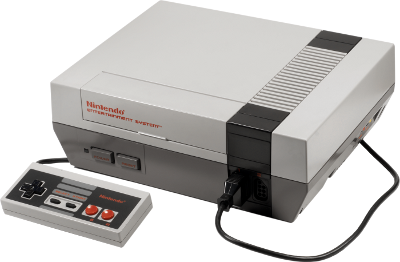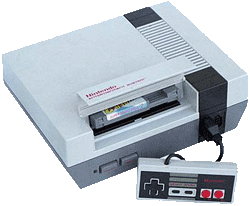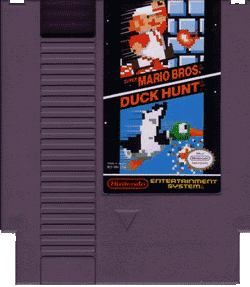Presentation :
The Nintendo Entertainment System is an 8-bit video game console that was developed and manufactured by Nintendo. It was initially released in Japan as the Family Computer (also known as the Famicom and abbreviated as FC) on July 15, 1983, and was later released in North America during 1985, in Europe during 1986, and Australia in 1987. In South Korea, it was known as the Hyundai Comboy and was distributed by SK Hynix which then was known as Hyundai Electronics. It was succeeded by the Super Famicom/Super Nintendo Entertainment System.
The best-selling gaming console of its time, the NES helped revitalize the US video game industry following the video game crash of 1983, and set the standard for subsequent consoles of its generation. With the NES, Nintendo introduced a now-standard business model of licensing third-party developers, authorizing them to produce and distribute titles for Nintendo's platform.
In 2009, the Nintendo Entertainment System was named the single greatest video game console in history by IGN, out of a field of 25. 2010 marked the system's 25th anniversary in North America, which was officially celebrated by Nintendo of America's magazine Nintendo Power in November 2010's issue #260 with a special 26-page tribute section. Other video game publications also featured articles looking back at 25 years of the NES, and its impact in the video game console market.


History :
Following a series of arcade game successes in the early 1980s, Nintendo made plans to create a cartridge-based console called the Famicom. Masayuki Uemura designed the system. Original plans called for an advanced 16-bit system which would function as a full-fledged computer with a keyboard and floppy disk drive, but Nintendo president Hiroshi Yamauchi rejected this and instead decided to go for a cheaper, more conventional cartridge-based game console as he felt that features such as keyboards and disks were intimidating to non-technophiles. A test model was constructed in October 1982 to verify the functionality of the hardware, after which work began on programming tools. Because 65xx CPUs had not been manufactured or sold in Japan up to that time, no cross-development software was available and it had to be produced from scratch. Early Famicom games were written on a system that ran on an NEC PC-8001 computer and LEDs on a grid were used with a digitizer to design graphics as no software design tools for this purpose existed at that time.
The code name for the project was "GameCom", but Masayuki Uemura's wife proposed the name "Famicom", arguing that "In Japan, 'pasokon' is used to mean a personal computer, but it is neither a home or personal computer. Perhaps we could say it is a family computer."
Meanwhile, Hiroshi Yamauchi decided that the console should use a red and white theme after seeing a billboard for DX Antenna which used those colors.
Original plans called for the Famicom's cartridges to be the size of a cassette tape, but ultimately they ended up being twice as big. Careful design attention was paid to the cartridge connectors since loose and faulty connections often plagued arcade machines. As it necessitated taking 60 connection lines for the memory and expansion, Nintendo decided to produce their own connectors in-house rather than use ones from an outside supplier.
The game pad controllers were more-or-less copied directly from the Game & Watch machines, although the Famicom design team originally wanted to use arcade-style joysticks, even taking apart ones from American game consoles to see how they worked. However, it was eventually decided that children might step on joysticks left on the floor and their durability was also questioned. Katsuyah Nakawaka attached a Game & Watch D-pad to the Famicom prototype and found that it was easy to use and had no discomfort. Ultimately though, they did install a 15-pin expansion port on the front of the console so that an arcade-style joystick could be used optionally. The controllers were hard-wired to the console with no connectors for cost reasons.
Uemura added an eject lever to the cartridge slot which was not really necessary, but he felt that children could be entertained by pressing it. He also added a microphone to the second controller with the idea that it could be used to make players' voices sound through the TV speaker.


The console was thus released on July 15, 1983 as the Famicom (lit. Family Computer) for ¥14,800 alongside three ports of Nintendo's successful arcade games Donkey Kong, Donkey Kong Jr. and Popeye. The Famicom was slow to gather momentum; a bad chip set caused the initial release of the system to crash. Following a product recall and a reissue with a new motherboard, the Famicom’s popularity soared, becoming the best-selling game console in Japan by the end of 1984.
Encouraged by these successes, Nintendo soon turned its attention to the North American market. Nintendo entered into negotiations with Atari to release the Famicom under Atari’s name as the name Nintendo Advanced Video Gaming System. The deal was set to be finalized and signed at the Summer Consumer Electronics Show in June 1983. However, Atari discovered at that show that its competitor Coleco was illegally demonstrating its Coleco Adam computer with Nintendo's Donkey Kong game. This violation of Atari's exclusive license with Nintendo to publish the game for its own computer systems, caused delayed the implementation of Nintendo's game console marketing contract with Atari. Atari's CEO Ray Kassar was fired the next month, so the deal went nowhere, and Nintendo decided to market its system on its own.
Subsequent plans to market a Famicom console in North America featuring a keyboard, cassette data recorder, wireless joystick controller and a special BASIC cartridge under the name "Nintendo Advanced Video System" likewise never materialized. By the beginning of 1985, the Famicom had sold more than 2.5 million units in Japan and Nintendo soon announced plans to release it in North America as the Advanced Video Entertainment System (AVS) that same year. The American video game press was skeptical that the console could have any success in the region, with the March 1985 issue of Electronic Games magazine stating that "the videogame market in America has virtually disappeared" and that "this could be a miscalculation on Nintendo's part."
At June 1985's Consumer Electronics Show (CES), Nintendo unveiled the American version of its Famicom. This is the system which would eventually be officially deployed as the Nintendo Entertainment System, or the colloquial "NES". Nintendo seeded these first systems to limited American test markets starting in New York City on October 18, 1985, following up with a full-fledged North American release of the console in February of the following year. Nintendo released 18 launch titles: 10-Yard Fight, Baseball, Clu Clu Land, Duck Hunt, Donkey Kong Jr. Math, Excitebike, Golf, Gyromite, Hogan’s Alley, Ice Climber, Kung Fu, Mach Rider, Pinball, Stack-Up, Tennis, Wild Gunman, Wrecking Crew, and Super Mario Bros.. Some varieties of these launch games contained Famicom chips with an adapter inside the cartridge so they would play on North American consoles, which is why the title screen of "Gyromite" has the Famicom title "Robot Gyro" and the title screen of "Stack-Up" has the Famicom title "Robot Block".
R.O.B. (Robotic Operating Buddy), an accessory for the NES's 1985 launch. Although it ended up having a short product lifespan, R.O.B. was initially used to market the NES as novel and sophisticated from previous game consoles.
The system was originally targeted for release in the spring of 1985, but the release date was pushed back. After test-marketing in the New York City area in late fall, retailers had reportedly stated the system "failed miserably". Nintendo tried a second time, the system was test-marketed further beginning in February 1986, with the nationwide release occurring in September 1986.
The system's launch represented not only a new product, but also a reframing of the severely damaged home video game market segment as a whole. The video game market crash of 1983 had occurred in significant part due to a lack of consumer and retailer confidence in video games, which had in turn been due partially to confusion and misrepresentation in the marketing of video games. Prior to the NES, the packaging of many video games presented bombastic artwork which exaggerated the graphics of the actual game. In terms of product identity, a single game such as Pac-Man would appear in many versions on many different game consoles and computers, with large variations in graphics, sound, and general quality between the versions. By stark contrast, Nintendo's marketing strategy aimed to regain consumer and retailer confidence, by delivering a singular platform whose technology was not in need of heavy exaggeration and whose qualities were clearly defined.
To differentiate Nintendo's new home platform from the early 1980s' common perception of a beleaguered and frivolous video game market, the company freshened its product nomenclature and positioning, and it established a rigorous product approval and licensing policy. The overall system was referred to as an "Entertainment System" instead of a "video game system", which was centered upon a machine called a "Control Deck" instead of a "console", and which featured software cartridges called "Game Paks" instead of "video games". The 10NES lockout chip system acted as a lock-and-key coupling of each Game Pak and Control Deck, deterring the copying or production of NES games which had not first achieved Nintendo's licensed approval. The packaging of the launch lineup of NES games bore pictures of a very close representation of the actual onscreen graphics of the game, which were of sufficiently recognizable quality on their own. Symbols on the launch games' packaging clearly indicated the genre of the game, in order to reduce consumer confusion. A 'seal of quality' was printed on all appropriately licensed game and accessory packaging. The initial seal stated, "This seal is your assurance that Nintendo has approved and guaranteed the quality of this product". This text was later changed to "Official Nintendo Seal of Quality".
Unlike with the Famicom, Nintendo of America marketed the console primarily to children, instituting a rather strict policy of censoring profanity, sexual, religious, or political content in games. The most famous case of this was Lucasfilm's attempts to port Maniac Mansion (a game with a considerable amount of unacceptable material) to the NES. NOA continued their censorship policy until 1994 with the advent of the Entertainment Software Rating Board system.
The optional Robotic Operating Buddy, or R.O.B., was part of a marketing plan to portray the NES's technology as being novel and sophisticated when compared to previous game consoles, and to portray its position as being within reach of the better established toy market. While at first, the American public exhibited limited excitement for the console itself, peripherals such as the light gun and R.O.B. also attracted extensive attention.
In Europe and Australia, the system was released to two separate marketing regions. One region consisted of most of mainland Europe (excluding Italy), and distribution there was handled by a number of different companies, with Nintendo responsible for most cartridge releases. Most of this region saw a 1986 release. Mattel handled distribution for the other region, consisting of the United Kingdom, Canada, Italy, Australia and New Zealand, starting the following year. Not until the 1990s did Nintendo's newly created European branch direct distribution throughout Europe.
The Nintendo Entertainment System's Control Deck
For its complete North American release, the Nintendo Entertainment System was progressively released over the ensuing years in four different bundles: the Deluxe Set, the Control Deck, the Action Set and the Power Set. The Deluxe Set, retailing at US$199.99, included R.O.B., a light gun called the NES Zapper, two controllers, and two Game Paks: Gyromite, and Duck Hunt. The Basic Set, retailing at US$89.99 with no game, and US$99.99 bundled with "Super Mario Bros." The Action Set, retailing in 1988 for US$149.99, came with the Control Deck, two game controllers, an NES Zapper, and a dual Game Pak containing both Super Mario Bros. and Duck Hunt. In 1989, the Power Set included the console, two game controllers, a NES Zapper, a Power Pad, and a triple Game Pak containing Super Mario Bros, Duck Hunt, and World Class Track Meet. In 1990, a Sports Set bundle was released, including the console, an NES Satellite infrared wireless multitap adapter, four game controllers, and a dual Game Pak containing Super Spike V'Ball and Nintendo World Cup. Two more bundle packages were later released using the original model NES console. The Challenge Set of 1992 included the console, two controllers, and a Super Mario Bros. 3 Game Pak for a retail price of US$89.99. The Basic Set, first released in 1987, was repackaged for a retail US$89.99. It included only the console and two controllers, and no longer was bundled with a cartridge. Instead, it contained a book called the Official Nintendo Player's Guide, which contained detailed information for every NES game made up to that point.
Finally, the console was redesigned for both the North American and Japanese markets as part of the final Nintendo-released bundle package. The package included the new style NES-101 console, and one redesigned "dogbone" game controller. Released in October 1993 in North America, this final bundle retailed for US$49.99 and remained in production until the discontinuation of the NES in 1995.
By 1988 industry observers stated that the NES's popularity had grown so quickly that the market for Nintendo cartridges was larger than that for all home computer software. Compute! reported in 1989 that Nintendo had sold seven million NES systems in 1988, almost as many as the number of Commodore 64s sold in its first five years. "Computer game makers scared stiff", the magazine said, stating that Nintendo's popularity caused most to have poor sales during the previous Christmas and resulting in serious financial problems for some. By 1990 30% of American households owned the NES, compared to 23% for all personal computers.
Despite the system’s lackluster performance outside of Japan and North America, by 1990 the NES had outsold all previously released consoles worldwide. The slogan for this brand was It can't be beaten. The Nintendo Entertainment System was not available in the Soviet Union.
As the 1990s dawned, however, renewed competition from technologically superior systems such as the 16-bit Sega Mega Drive/Genesis marked the end of the NES’s dominance. Eclipsed by Nintendo's own Super Nintendo Entertainment System (SNES), the NES’s user base gradually waned. However, even as developers ceased production for the NES, a number of high-profile video game franchises and series that started on the NES were transitioned to newer consoles and remain popular to this day. The last game released in Japan was Takahashi Meijin no Bōken Jima IV (Adventure Island IV), while in North America, Wario's Woods was the last licensed game; unlicensed games are still being produced to this day. In the wake of ever decreasing sales and the lack of new software titles, Nintendo of America officially discontinued the NES by 1995. Despite this, Nintendo of Japan kept producing new Nintendo Famicom units until September 2003, and continued to repair Famicom consoles until October 31, 2007, attributing the decision to discontinue support because of insufficient supplies of parts.
The NES was released after the "video game crash" of the early '80s, whereupon many retailers and adults had regarded electronic games as being merely a passing fad, and many believed at first that the NES was another fad. Before the NES/Famicom, Nintendo was known as a moderately successful Japanese toy and playing card manufacturer, and the popularity of the NES/Famicom helped the company grow into an internationally recognized name almost synonymous with video games and set the stage for Japanese dominance of the video game industry. With the NES, Nintendo also changed the relationship of console manufacturers and third-party software developers by restricting developers from publishing and distributing software without licensed approval. This led to higher quality software titles, which helped to change the attitude of a public that had grown weary from poorly produced titles for other game systems of the day.
The NES hardware was also very influential. Nintendo chose the name "Nintendo Entertainment System" for the US market and redesigned the system so it would give the appearance of a child's toy. The front-loading cartridge input allowed it to be used more easily in a TV stand with other entertainment devices, such as a video cassette player.
There were many prominent game franchises that originated on the NES. The system's hardware limitations led to game design similarities that still influence video game design and culture. Some of the more important franchises that debuted on the NES were Nintendo's own Super Mario Bros., The Legend of Zelda and Metroid, Capcom's Mega Man franchise, Konami's Castlevania franchise, Square's Final Fantasy and Enix's Dragon Quest franchises. All of these still exist today.
NES imagery, especially its controller, has become a popular motif for a variety of products, including Nintendo's own Game Boy Advance. Clothing, accessories, and food items adorned with NES-themed imagery are still produced and sold in stores. Such items include hats, shirts, underwear, wallets, wrist-bands, belt buckles, tins containing mint candy, and energy drinks.
Technical Specification :
- Main Processor : 8 bit Ricoh 2A03 clocked 1,7897725 MHz (NTSC) or 1.773447 MHz (PAL)
- Memory : 2 Ko
- Video : 8-bits PPU (Picture Processor Unit) from Ricoh
- Video Memory : 2 KB
- Resolution : 256x240,
- Colors : 52 colors (non standard RVB)
- Sprites supported hardware :
- max on screen : 64
- max per scanline : 64
- sprites size : 8x8 or 8x16 pixels
- Audio : PSG sound integrated (2a03)
- 4 channels PSG , 1 channel PCM
- 2 channels "square"
- 1 channel "triangle"
- 1 channel noise
- 1 channel PCM
- gamepad : 8 directionnal key, A, B, select, start
- Ports: 2 gamepad ports









.webp)
 (Hack).webp)
 (Rev A).webp)